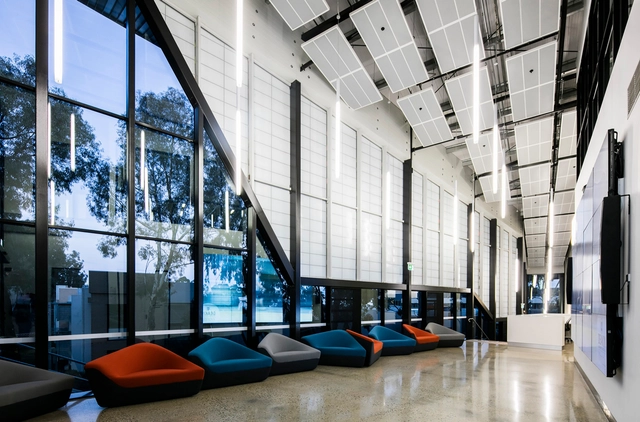
As societies evolve, educational facilities also undergo continuous transformation processes to keep up. In terms of their design strategies, they must embrace modern approaches that respond to the changing needs of students and teachers. Including flexible, inclusive, and engaging spaces that seamlessly integrate technological advances, contemporary educational design aims to enhance learning and collaborative work, as well as comfort and wellbeing.
Kalwall focuses on developing forward-thinking solutions for human-centered design that address these evolving needs, while responding to a tight budget. Through a collaborative strategy with architecture and engineering projects, they focus on four ways to design optimal learning environments, including daylight design, energy efficiency, safety, and cost savings through renovation and installation.

Daylight design: Maximizing natural light
Considering the fundamental connection between light and health, the design of educational buildings must prioritize natural daylight. By doing so, student performance can be enhanced, enabling faster progress. Within the various methods of introducing natural daylight, the installation of skylights and skyroofs create a more inviting atmosphere in hallways and common areas. By utilizing customized translucent materials in educational facilities, traditional solutions are optimized to maximize the building’s thermal performance.
When facing existing buildings, replacing windows with a new façade system reduces the need for artificial lighting by allowing floor-to-ceiling daylight to enter. Through the use of translucent panels, buildings are able to harvest natural daylight, maximizing the diffusion of light inside the building without any additional equipment or cost.

The Wolfe Center for the Arts, a collaborative space for classrooms, production, and studios, encourages the interaction between diverse groups of students. The naturally illuminated and spacious lobby creates views upward to the lounges, classrooms, and studios of art, music, and drama. Kalwall’s translucent façade panels, which bend sunlight like prisms, create a soft and even light that eliminates glare. The panels are customized in various configurations to adapt to the project layout.
Energy efficiency: Solutions for a sustainable future
As educational institutions shape the minds of the future, many are emphasizing the importance of sustainable design and its impact on the future environment. Kalwall focuses on energy efficiency as a key element for creating healthier and sustainable learning spaces.
Managing the solar heat gain coefficient (SHGC) of fenestration systems, including walls and skylights, is crucial for optimizing usable light while minimizing heat entrance. A low SHGC prevents excessive heat, thus reducing cooling expenses.
According to the Center for Climate and Energy Solutions, 41% of total energy usage comes from heating, ventilation, and air conditioning (HVAC). Therefore, implementing thoughtful daylighting designs reduces HVAC costs by creating the right thermal envelope. Kalwall strategies analyze visible light transmission (VLT), thermal insulation, and solar gain control properties to customize solutions for each project.

The Georgia Tech Carbon Neutral Energy Solutions Laboratory exemplifies how a learning environment can approach net-zero carbon emissions. This project applies Kalwall panels to create curtain walls that diffuse natural light while controlling heat gain. The system simplifies the design by eliminating the need for blinds, curtains, or solar control.
Safety: Material strategies for protecting educational spaces
Enhancing safety in building design involves increasing lighting in common areas and walkways, well-designed entry and exit points, and the use of materials resistant to windborne debris.
Translucent materials can contribute to safer environments as they provide line of sight protection for students. Illuminated translucent canopies -–which create safer connections between buildings– enable a safer entryway, aiding wayfinding and minimizing light contrast ratios that could hinder visibility during in and out transitions.
In regions prone to natural disasters like hurricanes and tornadoes, learning spaces require protection from windborne debris. Unlike most traditional glass and polycarbonate materials, Kalwall’s strategies offer heavy impact resistance, water penetration prevention, structural performance, and air infiltration.

The Tintern Middle School project features a pair of ‘floating’ learning pavilions that promote connection and interaction between spaces. By maximizing natural light in both pavilions and their transition space, Kalwall cladding and glazing systems allow diffuse, glare-free, natural daylight to penetrate through translucent wall panels.
Cost savings through renovation and installation
Renovating existing structures is a green building trend that has been increasingly adopted in educational facilities with a history spanning decades or even centuries. By implementing new strategies like skyroof systems, old spaces can be transformed into vibrant learning areas filled with diffused natural light.
Unlike double- or triple-glazing, which often exceed structural limits, the use of lightweight materials that integrate easily into existing structures reduces the preparation and manpower required for quick and straightforward recladding of the building skeleton.
During educational building renovations, it is crucial to complete the installation promptly to ensure uninterrupted classes. Prefabricated or pre-assembly solutions that keep materials off-site play a key role in minimizing future installation requirements.

An example of this transformation can be seen in the renovation of Featherstone High School, a 1958 concrete-framed building. The project involved removing old concrete spandrel panels and repairing the structure. Supported by a new steel frame, Kalwall panels were installed to expand the floor space. These new façades allow diffused daylight to flood the interior from floor to ceiling, while providing privacy for students. The renovation was completed in two phases, saving time and expenses by using unitized walls that were pre-assembled and glazed.
For more information on material solutions for designing learning environments, visit the product catalog.
























